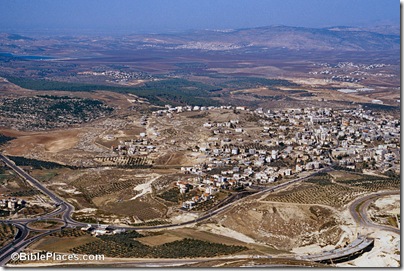 |
| view of Gath Hepher, courtesy, BiblePlaces.com |
When the Israelites
crossed over into the Land of Canaan, Elizaphan, son of Parnach, led Zvulun and
represented the tribe when the land was divided. The tribal allotment to Zvulun
was described in the Book of Joshua 19:10-15: “And the third lot came up for the children of Zvulun according
to their families; and the border of their inheritance was unto Sarid; And their border went up toward
the sea, and Maralah, and reached to
Dabbeshet, and reached to the [Kishon?] river that is before Yokneam; And turned from Sarid eastward
toward the sunrising unto the border of Chisloth-tabor,
and then goeth out to Daverat, and
goeth up to Japhia, And from thence
passeth on along on the east to Gath Hepher,
to Ittah Kazin, and goeth out to Remmon Methoar to Neah; And the border compasseth it on the north side to Hanaton: and the outgoings thereof are
in the valley of Jiphthah El; And Kattath, and Nahalal, and Shimron,
and Idalah, and Bethlehem: twelve cities with their villages.” Of the nineteen locations listed, only Bethlehem
of Galilee (seven
miles northwest of Nazareth) can be identified with certainty, although the
archaeological site Tel
Hanaton is
associated with the city Hanaton listed as on the boundary
with Asher.
In the ancient Song of Deborah, Zvulun is described as sending to battle those that
handle the sopher shevet. Traditionally this has been interpreted
as referring to the "rod of the scribe", an object that in Assyrian monuments was a wooden or metal stylus used to inscribe on clay tablets or papyrus; thus, those who wielded it would have
been the associates of lawgivers. Therefore, in Jewish tradition, the
tribe of Zvulun was considered to have a symbiotic relationship with the tribe of Issachar, its neighbor and a tribe that traditionally was seen as having
many scholars who disseminated the teaching of Torah and learning. They tended
to be financially supported by Zvulun who would, in turn, receive a share of
the spiritual reward from such learning.
During the
time of the Judge Gideon, the tribe answered the call to join in the battle
against Midian (Judges 6:35). Among Gideon’s successors was the Zvulunite Elon, who sat as judge of the nation for ten years (Judges 12:11). Of those who followed David to Hebron to make him king were 50,000 fully armed men of Zvulun with
no double heart (I Chronicles 12:33), who brought with them, as a
sign of their hearty allegiance, bounteous supplies of meat and drink to
celebrate the accession of their new ruler (I Chronicles 12:41). When Hezekiah made reparation for the abominations of his father Ahaz, he
invited all Israel, whether in the southern Kingdom of Judah or the northern
Kingdom of Israel, to keep the Passover in the House of the Lord. Mockery and ridicule met his emissaries.
Yet some were true to the religion of their fathers, and, even from far away Zvulun,
they made the pilgrimage to Jerusalem, and in the process, destroyed the idols there (II Chronicles 30:10–23). As part of the Kingdom
of Israel, the
territory of Zvulun was conquered by the Assyrians, and they,
along with the 10 other tribes that made up the Kingdom of Israel, were exiled, and soon became known as
the Lost Tribes of Israel – until in very recent years.
Since then,
Jews/Israelites, mostly of the tribe of Judah, have resettled the area. According
to the Christian New Testament, Jesus was raised in Nazareth which is in Zvulun
territory. The Gospels relate much about his Galilean ministry which mainly took
place in this territory. After the Roman destruction of Jerusalem in 70, Jews
still lived in the area, but on and off. The Tomb of Jonah in Gath Hepher became a place of pilgrimage. It was even
mentioned in the 12th century by the Jewish medieval geographer Benjamin of Tudela. The ancient Zvulunite
town of Shimron was mentioned by the geographer Ishtori Haparchi in his "Kaftor va-Feraḥ" in 1322. In
1850, the ancient site of Nahalal was identified by the geographer and
scientist Rabbi
Joseph Schwarz. In
1921, most of the Jezreel Valley,
which mostly lies within Zvulun territory, was acquired by the Palestine Land
Development Company, a Jewish company under Yehoshua Hankin, as part of
the Sursock Purchase.
(The Sursock family was a Greek Christian family of Beirut.) That year, Nahalal
was reestablished as the first moshav ovdim (workers' cooperative
agricultural settlement). (see Jezreel Valley, Nahalal) In 1926, Sarid was established as a
kibbutz by Jews from Czechoslovakia, Poland and the Soviet Union. On the other hand, by 1931, only 1
Jew lived in Bethlehem of Galilee, then, a settlement of German Templars. The
first families arrived in Yokneam in 1935. In 1936, Kibbutz Hazorea was established by German Jews.
That same year, the site of Shimron became an agricultural training station for
the Moshavim Movement,
becoming Kibbutz Timorim in 1948. Kibbutz Dovrat
was established on October 30, 1946 on the ancient site of Daverat by members
of the Zra'im group, mostly Jews from Austria and Germany who arrived
before the start of World War II. Shortly after the War
of Independence, Jewish farmers began to move into the region, joining existing
communities and establishing new ones such as Bethlehem of Galilee.
Israeli Knesset member Ayoob Kara, a member of the Druze community, speculated that the Druze are descended from one of the Lost Tribes of Israel, probably Zvulun. Kara stated that the Druze share many of the same beliefs as Jews, and that he has genetic evidence to prove that the Druze were descended from Jews.
No comments:
Post a Comment